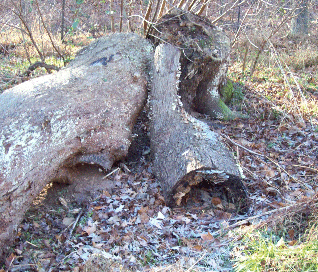|
BUILDING RABBIT HABITAT BURROWS by Dr. Bruce Gabrielson One of the problems I had for years in my starting pen was the ability to raise many young rabbits. There are many trees in my pen, so hawks and owls are a problem I live with constantly. My brush piles are well developed, and offer plenty of places for the rabbits to hide. However, since rabbits usually won't build their own underground den, and since I only have rabbits in my pen, having suitable places for the rabbits to hide and give birth was something I really didn't think about for a long time. This article will discuss a couple of techniques I've come up with that provides plenty of places for female rabbits to be safe and have babies while at the same time allow access when I need rabbits up for a run.
The Drain Pipe Den (I like to call it that) is basically about a 2 ½ to 3 foot length of 6" black corrugated plastic drain pipe (as shown in Figure 1) open in the front and positioned between two heavy logs as you go towards the back. You need a longer pipe for the rabbits to feel safe with a front and back entrance, plus you need the pipe wedged in so a hound can't dig it out to get to the bunnies inside. I make sure to cover the pipe with bark and smaller logs across the top in back, plus I lay another short log or solid branch on an angle across the front (see Figure 2) to make sure a dog can't see directly into the front of the pipe if they try.
I
also use a piece of old plywood covering a large area of the rear of the tile. Plywood keeps
the rain and snow off. I decided to add this by following rabbit tracks one
winter after several snow falls. I noticed that the dens which were used most
often year around were those dens that offered a good layer of air and
undergrowth. In snow, rabbits will den in the pipe, but crawl up through the
rear pile to the surface when the snow lasts more than a couple of days. I also
notice that the dens most quickly occupied are those closest to my rabbit
feeders. Rabbits are territorial and once the den becomes occupied, a rabbit
will tend to stay there for a long time. Another thing I've found
interesting about my dens is that snakes (which I get sometimes but not often)
don't seem to like the corrugated pipe to hide in. I've found snakes in brush
piles but I've never found a snake in one of the pipes. Rabbits do like brush piles, but
need to get out to eat, cool off in the heat, and sometimes to have fun running
from my dogs, especially if the pups are little. Another favorite hiding place
for my rabbits is my lean-to shelters. My first lean-to shelters were pretty
much useless and I never saw a rabbit in one. Nowadays rabbits are always around
the shelters in the early evenings and mornings. The typical lean-to is depicted
in Figure 4 (above left). Basically, a couple of supports with a leaning
structure being held up behind it. At first I used plywood but could never get a
rabbit to hide under the structure. What happened to make the shelters more
desirable? I have a couple of other dens
that my rabbits sometimes occupy. I found a hollow tree and cut it down. Then I
sawed it into several 2 to 2 ½ foot long sections. These I've conveniently
placed all around my pen, sometimes under brush piles. I also have another tree
hollow at the base. I needed to nail a piece of plywood across most of the
opening so a dog could not get in but a rabbit could. All articles are the copyrighted
property of the author |
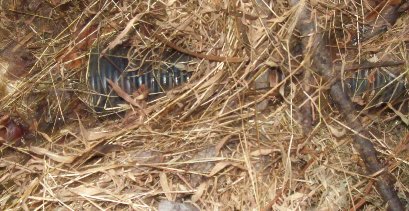 Drain
Pipe Den
Drain
Pipe Den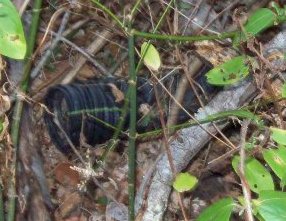 Figure 2 (right) shows the front of such a den. I've noticed that rabbits will
run if they can see the hound looking straight down the pipe. The rear of the
pipe is similarly covered. To help with young rabbits, push some dry leaves into
the bottom of the pipe at least a foot back. Also make sure the pipe isn't in a
low spot where water can run in. If you want to flush an older rabbit out,
simply move the front log and push your stick into one end and out pops the
rabbit on the other.
Figure 2 (right) shows the front of such a den. I've noticed that rabbits will
run if they can see the hound looking straight down the pipe. The rear of the
pipe is similarly covered. To help with young rabbits, push some dry leaves into
the bottom of the pipe at least a foot back. Also make sure the pipe isn't in a
low spot where water can run in. If you want to flush an older rabbit out,
simply move the front log and push your stick into one end and out pops the
rabbit on the other.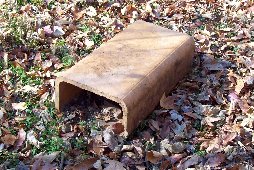 Figure 3 (left) shows another tile drain pipe before modifying into a den.
In this case, I fit a small piece of plywood covering about 1/2 the front and back of the pipe.
Onec it's fitted, it's buried or covered with branches.
Figure 3 (left) shows another tile drain pipe before modifying into a den.
In this case, I fit a small piece of plywood covering about 1/2 the front and back of the pipe.
Onec it's fitted, it's buried or covered with branches.
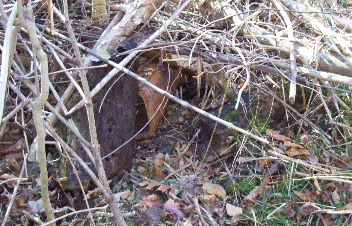 Figure 4 (right) shows the pipe
covered with brush. This happens to be my most used
and successful bunny producing den. What I've done is lean a log over the front and create a brush pile on
the back of the den so that there is a larger area for the babies to move into.
Figure 4 (right) shows the pipe
covered with brush. This happens to be my most used
and successful bunny producing den. What I've done is lean a log over the front and create a brush pile on
the back of the den so that there is a larger area for the babies to move into.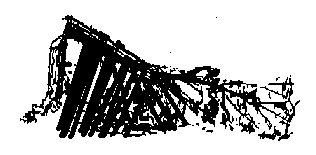 Lean-To
Shelter
Lean-To
Shelter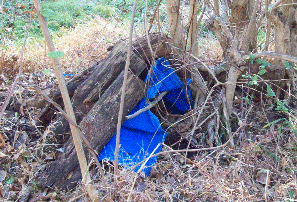 The picture in Figure 5 (right) shows an actual lean-to in my pen. One time I
decided to use a piece of rabbit wire when I didn't have any plywood handy. To
keep the structure stable, I put a few sticks over it. All of a sudden, rabbits
use the structures continuously. I'm no where near an expert on rabbit
psychology, but I've got some ideas on this. I really think that the rabbits
feel safe since they can see and hear all around while still not having to worry
about being snagged by a flying vermin. I use a piece of plastic under the
logs to keep water from leaking through.
The opening to the structure points away
from my paths and there is grass under the structure during the spring through
fall. Also, winter leaf fall doesn't fill the under area.
The picture in Figure 5 (right) shows an actual lean-to in my pen. One time I
decided to use a piece of rabbit wire when I didn't have any plywood handy. To
keep the structure stable, I put a few sticks over it. All of a sudden, rabbits
use the structures continuously. I'm no where near an expert on rabbit
psychology, but I've got some ideas on this. I really think that the rabbits
feel safe since they can see and hear all around while still not having to worry
about being snagged by a flying vermin. I use a piece of plastic under the
logs to keep water from leaking through.
The opening to the structure points away
from my paths and there is grass under the structure during the spring through
fall. Also, winter leaf fall doesn't fill the under area.